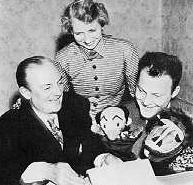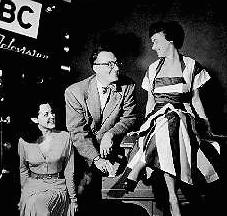WMAQ-TV began
regular commercial operations on January 7, 1949 in the renovated Radio Studio
A, its first complete TV studio. Programming was scheduled for a minimum of two
hours a day.
Eight regular programs began in January. Irna Phillips, of radio soap opera fame,
wrote "These Are My Children'', which became the first daytime television
serial. Walter E. Durbahn, a high school manual training teacher, produced "Walt's
Workshop", television's first do-it-yourself program. John Conrad and Hugh
Downs starred in an audience participation show called ''Take a Dare". The
Quiz Kids starred in a TV version
of their popular radio show of the same name. Bob Murphy had a farm program called
''RFD America". Boxing matches from Marigold Gardens were a weekly attraction.
And finally, there was a news-weather package featuring newsman Clifton
Utley and Clint Youle, who was recruited from the news-writing staff to become
Channel 5's first weatherman.
 |
Left:
A Highland Park manual training teacher, Walt Durbahn, became the star of television's
first "how-to-do-it" program, "Walt's Workshop".
|
Chicago and the midwest
were linked to the east coast TV network via cable and microwave on January 11th,
1949. Chicago's first offering to the NBC network was "Kukla,
Fran and Ollie" featuring Burr Tillstrom and Fran Allison. It led the
parade of original and unique programming that placed WMAQ-TV in the forefront
of the celebrated "Chicago School" of television in the early I950's.
| Right:
Jules Herbuveaux (seated left), Channel 5's first manager, signs Burr Tillstrom
and Kukla and Ollie as WMAQ-TV's first regular network program. KFO Manager Beulah
Zachary looks on. |
 |
Station Manager Jules
Herbuveaux felt that TV should be honest, and refuse imitation. He said, "If
you want to show carpentry, don't hire an actor. Hire the best carpenter you can
find and he will hold your audience's attention."
Later, in writing about the ''Chicago Style'', Herbuveaux said, "The Garroway
At Large show exemplified "Chicago Style". But the term embraced
anything out of Chicago studios blessed by lack of facilities, meager budgets,
few big names and a maximum of inventiveness. Wayne
King; Kukla, Fran and Ollie; Super Circus; Stud's
Place; Hawkins Falls; Ding
Dong School; Down You Go and a dozen other shows came out of Chicago to delight
viewers and critics and to confound television experts with their simplicity and
originality. As wide-eyed newcomers to television programming, we in Chicago approached
the medium with the idea that it was neither radio, motion pictures nor the Broadway
stage.
"Practitioners of the Chicago School---talent, producers, directors, writers
and others graduated to invade the cloistered confines of Radio City and Hollywood
and Vine, spreading the gospel of simplicity and intimacy in TV programming.
"The Chicago approach became standard operating procedure throughout the
industry, and for that alone, the industry owes a debt to our bailing wire, packing
box studio operations of the early 50's.
As 1949 grew older, a number of Channel 5 programs made their debuts. Herbie Mintz
in "But Not Forgotten". Dave Garroway with his "Garroway At Large".
"The Wayne King Show",
which was seen on the NBC Midwest network. Marlin Perkins' "Zoo
Parade''. "Portrait of America". Studs Terkel in "Stud's
Place". And "Vic and Sade", based on the old radio favorite
and with the same cast.
The "Garroway At Large" program, starring Dave
Garroway, who began his career as a WMAQ radio disc jockey, went on the network
from Chicago for the first time on April 16, 1949.
 |
Left: "Garroway
at Large" set the pace for the "Chicago School? of television production.
Dave is shown here with singers Connie Russell and Bette Chapel. |
During 1950, WMAQ-TV's
inventive live programming was praised in a number of published articles. Among
them was a Time Magazine story which said Channel 5 "specialized in simplified
realism" and "ad lib drama".
At the time, NBC star Fred Allen was quoted as saying that Chicago's shows were
"short on money, short on big-name talent, but long on inventiveness ."
The March 17, 1951 issue of Collier's magazine called Chicago the "Top TV
Town". The article said, "In Chicago they don't lavish money on costly
trappings. They turn out quiet, casual little shows and the audiences love them."
Collier's also told the story of Clarence Hartzel who took a 40-dollar beard,
a paper-mache rock and a canvas painting of a western scene to create a children's
program called "Cactus Jim". Hartzel's task was to introduce old western
movies. Within 17 months, he had a 33 rating, sixth highest in the nation, ahead
of the network's "Philco TV Playhouse" and "Your Show of Shows".
The Collier's
article said that showman Billy Rose so admired "Stud's Place" that
he wanted Studs Terkel, the creator, as his TV producer. When Terkel declined,
Rose hired Terkel's director, Dan Petrie. It was noted that Fred Waring hired
Dave Garroway's first director, Bob Banner. Today Banner is one of the top creative
producers in TV.
According to the Collier's story, Fred Allen and Robert Montgomery spent several
days in Chicago observing camera angles of the "Garroway At Large" show
before attempting their own productions. Chicago director Norman Felton went to
New York to become director of the "Robert Montgomery Playhouse".
Broadcasting-Telecasting magazine praised WMAQ-TV in May, 1954 for developing
what it called "single personality" features and "how to do it"
programs. The magazine said Channel 5's specialized shows for specialized audiences
had found audience and sponsor acceptance.
Broadcasting-Telecasting added that if any station could be said to be primarily
responsible for the Chicago school of television, it would be WMAQ-TV. The magazine
cited such programs as "Garroway At Large", "Kukla, Fran and Ollie",
"Zoo Parade" and "Ding Dong School" with child psychologist
Frances Horwich, a program that started on the station in February of 1953.
|
Right:
Frances Horwich became television's best known pre-school teacher as hostess of
Channel 5's "Ding Dong School".
|
 |
Other programs that
created audience and industry-wide interest in the early I950's were Francois
Pope's "Creative Cookery", "Championship Bowling" and "Championship
golf". "Championship Bowling" was the first program of its type,
and originated as a remote telecast from the Faetz-Niessen alleys on Chicago's
north side. After a very successful live run on Channel 5, it went on to become
a popular syndicated program.
News was, by then, making an impact in TV. One of the most popular programs was
WMAQ-TV's ''Five Star Final", a news-weather-sports and entertainment package
presented each weeknight between 10 and 11 PM. It featured newsman Clifton Utley;
weatherman Clint Youle; Dorsey Connors, a do-it-yourself expert; sports commentator
Tom Duggan and pianist Herbie Mintz.
WMAQ-TV began the first televised golf tournaments with "Championship Golf".
The seven-hole matches, featuring two pros and two amateurs, originated Tuesday
nights at Tam O'Shanter Country Club near Chicago, with the action played under
lights.
|